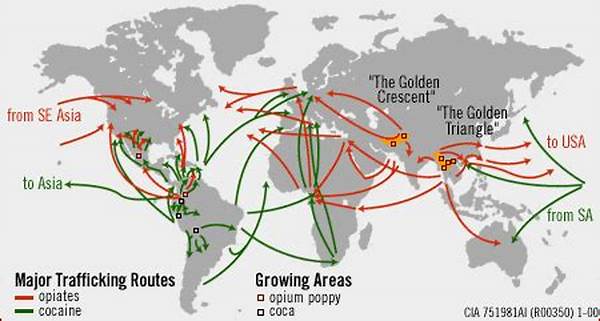The issue of illegal immigration remains a pressing concern for governments worldwide, with illegal immigration route networks playing a critical role in how individuals cross borders unlawfully. These clandestine pathways, often fraught with peril and exploitation, pose significant challenges to border security and humanitarian agencies alike. Understanding the dynamics of these networks is vital for developing comprehensive strategies to manage and mitigate their impact.
Dynamics of Illegal Immigration Route Networks
Illegal immigration route networks operate through a complex web of pathways, facilitated by human traffickers and smugglers who exploit vulnerable individuals seeking better opportunities. These networks span continents, linking countries through both well-trodden paths and innovative routes designed to evade detection. As a result, national and international efforts to curb illegal immigration must contend with constantly evolving strategies employed by these networks.
The prevalence of illegal immigration route networks is driven by various factors, including economic disparities, political instability, and social unrest in countries of origin. Migrants are often compelled to undertake treacherous journeys, risking life and limb in pursuit of safety or improved livelihoods. The networks capitalize on this desperation, charging exorbitant fees and often subjecting migrants to inhumane conditions. Consequently, the phenomenon of illegal immigration route networks requires comprehensive understanding and coordinated action among nations to address the root causes and mitigate the adverse effects on migrants and host countries alike.
Challenges in Combating Illegal Immigration Route Networks
1. Complexity: Illegal immigration route networks are intricate, involving multiple actors and stages, which makes dismantling them a formidable task.
2. Adaptability: These networks rapidly adapt to changing enforcement measures, creating new routes and methods to circumvent barriers.
3. Transnational nature: Operating across borders, these networks require international cooperation for effective intervention.
4. Humanitarian concerns: Authorities must balance security objectives with the need to provide assistance to migrants in distress.
5. Economic factors: Combating illegal immigration requires addressing the underlying economic incentives that drive migrants to seek out these networks.
Impact on Origin, Transit, and Destination Countries
Illegal immigration route networks significantly affect countries from which migrants depart, as well as those they transit through and ultimately reach. Countries of origin face the loss of human capital and are often burdened by the social and economic pressures that drive migration in the first place. Meanwhile, transit countries struggle with the influx of migrants, which can strain public services and exacerbate existing social tensions.
Destination countries also experience challenges, including increased pressure on border enforcement and potential social integration issues. The presence of illegal immigration route networks complicates efforts to control immigration flows and uphold national security. Thus, a collaborative approach involving origin, transit, and destination countries is essential for tackling the pervasive issue of illegal immigration route networks effectively.
Strategies to Mitigate Illegal Immigration Route Networks
Developing strategies to combat illegal immigration route networks involves multifaceted approaches. Enhanced international cooperation is crucial, allowing for intelligence-sharing and joint operations to disrupt these networks. Strengthening border security technologies and personnel capability is also imperative, allowing for more precise detection and interception of illegal crossings. Additionally, promoting economic development and stability in origin countries can help address the push factors of illegal immigration.
Raising public awareness about the dangers associated with illegal immigration route networks can deter potential migrants from undertaking dangerous journeys. Finally, legal pathways for migration should be expanded to offer viable alternatives, reducing the demand for clandestine routes. Understanding these strategies underscores the need for sustained, cooperative efforts to effectively manage illegal immigration route networks and their far-reaching consequences.
Role of Technology in Addressing Illegal Immigration Route Networks
Technological advancements offer powerful tools for addressing illegal immigration route networks. Sophisticated surveillance systems, including drones and biometric entry-exit tracking, enhance border monitoring and improve the identification of unauthorized crossings. Data analytics and AI can be employed to predict and identify trends within illegal immigration route networks, enabling preemptive measures.
Furthermore, technology facilitates international cooperation through the sharing of intelligence and real-time data among nations. Secure communication platforms allow for coordinated responses, enhancing the efficacy of transnational operations against illegal immigration route networks. By leveraging cutting-edge technologies, governments can improve their ability to address this complex challenge while minimizing the risks to migrants.
Humanitarian Concerns and Legal Measures
Addressing illegal immigration route networks necessitates a balance between enforcement and humanitarian considerations. Migrants often endure human rights abuses at the hands of traffickers, necessitating robust legal frameworks to prosecute those responsible and protect the victims. International conventions and treaties serve as vital instruments in harmonizing legal measures against illegal immigration networks across borders.
On-the-ground humanitarian assistance is crucial in providing immediate relief to migrants caught within these networks. Collaborative efforts between governments, non-governmental organizations, and international bodies can ensure comprehensive support, safeguarding migrant welfare while addressing illegal immigration route networks.
Conclusion
In summary, illegal immigration route networks present a multifaceted challenge that encompasses security, economic, and humanitarian dimensions. Combating these networks demands coordinated international efforts, innovative strategies, and an emphasis on both enforcement and protection. Understanding the complexity of illegal immigration route networks and their pervasive impact is paramount in crafting effective responses.
Ultimately, success in addressing illegal immigration route networks lies in a holistic approach that prioritizes collaboration among nations, integrates advanced technologies, and remains vigilant to the ever-evolving tactics employed by these networks. Through sustained efforts and a commitment to addressing root causes, it is possible to mitigate the adverse effects of illegal immigration route networks on individuals and nations alike.





